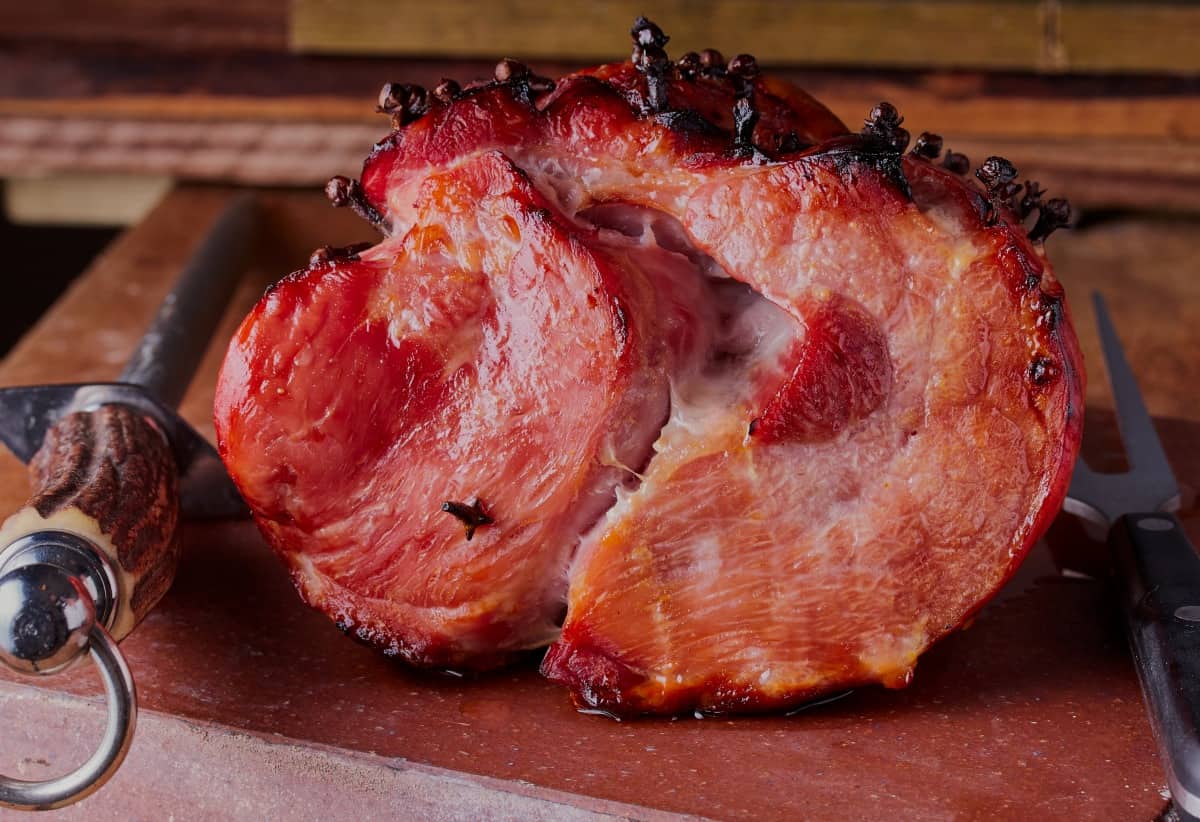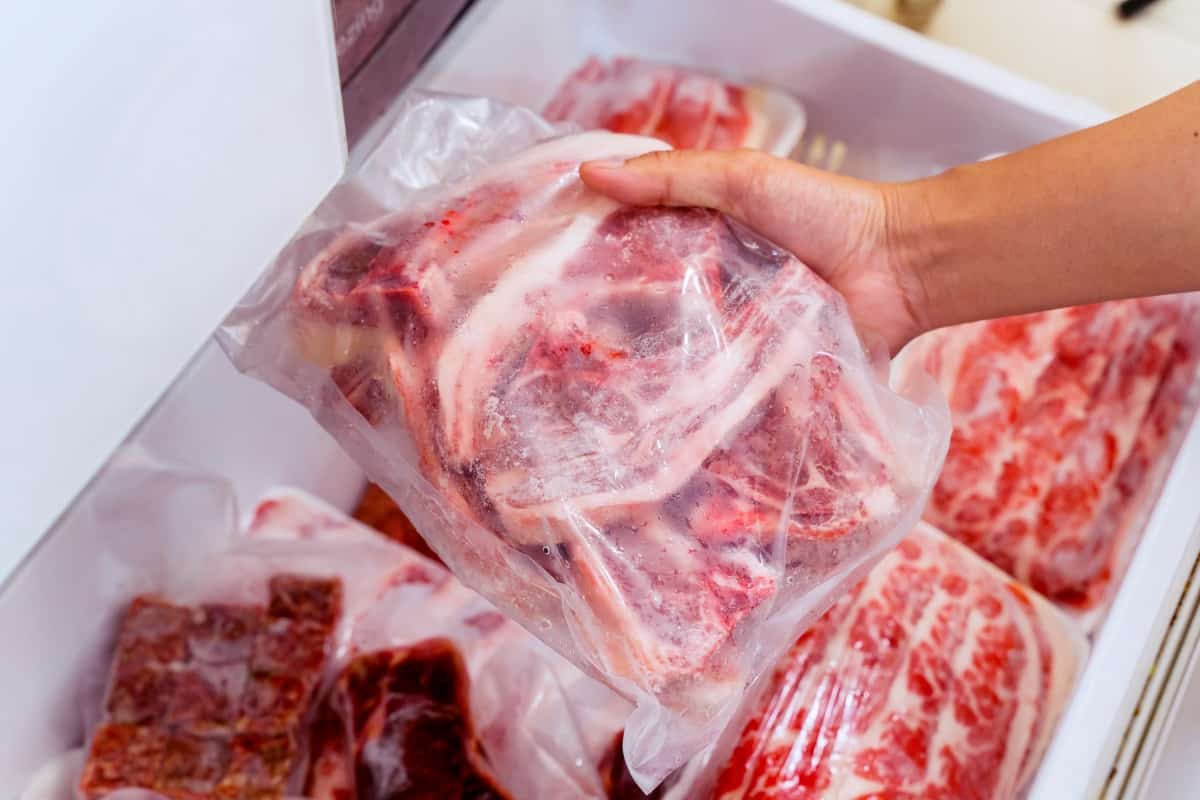Is It Safe to Reheat Ground Beef Multiple Times
Leftovers are a delicious dilemma which comes from having more meat coming off the grill than there are mouths to eat information technology hot when it's at its very best.
As discussed in previous articles, there are methods for reheating pulled pork, for reheating steak, and reheating brisket, techniques which can be extended to other meats.
But if you lot don't eat all that you reheat, the obvious question is: Simply how many times can you lot reheat food?
And can you yet have everything you want — flavor and texture — and none of what you don't want, such as dryness, stringiness, sickness inducing bacteria?
In this commodity, nosotros answer the question: How many times tin you reheat meat? And we provide a few tips on the best means to safely store meat, and to reheat the meats we dearest, sometimes numerous times.
And so, permit's delve into the globe of the echo meat reheat.
Contents (Leap to Topic)
- 1 Safety Implications
- ii Cooling Down your Cooked Meat
- 3 Freeze, Thaw, and Freeze Again
- 4 In one case More than, Into the Oestrus
- v Defrosting from Deep Frozen
- five.one H2o Baths
- 5.2 Reheating Nutrient in the Microwave
- 5.3 Reheating in the Oven
- 5.4 Reheating Sous Vide-Fashion
- 5.5 Reheat Using the 2-Zone Grill
- 6 The Food Version of the Police of Diminishing Returns
- seven So, Just How Many Times Can You lot Reheat Nutrient?
Rubber Implications

When storing and reheating meat, the obvious master concern should be to avoid poisoning yourself and your guests.
As discussed in other articles, bacteria will multiply within what the US FSIS calls the danger zone, between xl° and 140° F. Steer clear of those temperatures from the time you buy the meat to the time the last morsel is blissfully downed.
When information technology comes to reheating food:
- NEVER use a tiresome cooker, steam tabular array, or chafing dish. It takes as well long for nutrient to leave of the danger zone. Once heated, the meat tin be kept warm for hours using whatsoever of those containers. But it has to stay higher up 140 °F for the duration until it's eaten or refrigerated for another repast.
- Bring sauce to a boil. Beingness in contact with the meat earlier storing abroad could mean bacteria is waiting for an opportunity to grow.
Cooling Down your Cooked Meat

Safety reheating begins with safe food storage.
Meat — in fact, any cooked food — can safely be left off the heat for 2 hours. After that, it's just a matter of how fast (and maybe what variety of) bacteria will abound. You won't be able to encounter anything growing, but their presence volition definitely be felt. Possibly over many unpleasant hours or days.
Earlier the two hours are up, wrap the meat well in plastic or foil. Be sure it's completely covered, with no gaps or holes to allow air in or juice out. Or utilize apartment, air-tight containers.
The U.S. Food Safety and Inspection Service, an agency of the Department of Agriculture (USDA), recommends storing all cooked foods in shallow containers and small portions, so their temperature will quickly get down below the danger zone (40 degrees).
Modern refrigerators can adjust hot foods simply if y'all're uncomfortable with that, place the meat into storage numberless and submerge in an ice water bath for a few minutes.
You can safely shop your meat in the refrigerator for upwardly to four days. If you haven't finished information technology by and so, says the FSIS, freeze it in pocket-size, air-tight portions. In one case frozen, it will go along indefinitely; but for optimal flavor, it should exist used within four months.
Freeze, Thaw, and Freeze Again

If y'all've already frozen meat in a large batch, you can thaw it in the fridge, accept out a portion for reheating, and refreeze the rest.
As long as information technology never goes in a higher place 5 degrees, which information technology will non in your fridge, then this is perfectly OK — and safe — to do.
In one case More than, Into the Heat
When you lot're gear up to reheat, plan well in advance because some reheating methods can take many hours or fifty-fifty a twenty-four hours or more than.
Rapid reheating volition get the job washed quickly merely at the cost of texture and flavor. For large meats, the slower the thaw, the juicier the end result.
Defrosting from Deep Frozen
Meat should become from the freezer into the refrigerator for condom thawing, says the FSIS.
Plan for at least a day earlier it's ready for reheating. For large servings, the rule is 24 hours for every five pounds. Are at that place other ways? Yes. Merely they crave either time, space, effort, and equipment. Is it faster? Mayhap.
Hither are some such thawing methods:
Water Baths
Water baths — cold, very cold, or fifty-fifty sometimes hot. This may non be for you if your kitchen infinite is compact. To use a h2o bath method to defrost, yous volition need:
- A container large plenty to submerge meat
- Lots of water
- A digital thermometer
- Something to stir with (water correct around the thawing meat gets very cold. Giving the water an occasional stir breaks up the super cold water, then the thawing process tin move along.)
- A plate, lid, or other weight to keep the meat entirely underwater
- Water ice or fire, depending on which bath you choose
Cold or Very Common cold Water Bathroom Technique
- Gauge 30 minutes per-pound
- Place meat in an unzipped h2o-proof plastic bag
- Slowly submerge into a container of h2o at or below 40° f, keeping zipper above the water (This is to force air out of the bag)
- Carefully cypher the pocketbook airtight
- Go along the bag completely submerged, use a weight if necessary
- Add together more than water or ice cubes every hour — The more ice added, the slower the thaw, the more than fluid will be kept in the meat
Hot Water Bath Technique
- Only utilise this method for steaks, chops, or other cuts no more than than an inch thick. According to the USDA, you tin can safely thaw steaks with this method with a minimal loss of texture or moisture
- eleven minutes at 102° F
Reheating Food in the Microwave
Utilise medium power (50%) and a longer thaw time to keep meat from getting tough. Reverse to popular belief, microwaves don't heat nutrient from the inside out, says the FSIS. The radiations tin can't attain further than 1½ inches deep. Beyond that, the oestrus travels into the centre from the outer layer.
Thick cuts will need a lot of time. For some, this could be a drawback to thawing past microwave. And, says the USDA, different the hot interior of a heated oven, the inside a microwave is at room temperature — something else to boring the thawing process.
If microwave thawing is still for yous, remember simply to use microwave-safe glass or plastic containers. Cover meat with white paper towels, wax or parchment paper, or a domed glass or plastic container to incorporate splatters and juice.
Reheating in the Oven
The Food Safety and Inspection Services say foods should reach 165° F earlier serving, whether they are being reheated on the stovetop, in the oven, or on the grill.
Meathead recommends placing the meat in a double-layered foil packet with a little liquid (you could first coat it with sauce). Identify on a cooking sheet or in a baking pan.
Go low and slow on the estrus, 225° F, to keep the meat from drying out as it heats.
Rut until internal temp reaches 155° F (165 °F says FSIS). And a few minutes under the broiler after volition add crisp to the chaff.
Reheating Sous Vide-Style
Meat stored in the fridge can be reheated at 134-140 °F, for 45 minutes per inch of thickness. Permit an extra 30 minutes if it's frozen.
Reheat Using the 2-Zone Grill
Identify meat over indirect heat (225 °F) until the inside reaches 155 °F. Place over direct heat for 5-x minutes to revive the crunch of the crust.
The Food Version of the Constabulary of Diminishing Returns
Used in economics, the concept of the law of diminishing returns — A continual increase in effort does not lead to a continual increment in results — tin can definitely apply to reheating meat.
Almost of the meat'south flavor comes from the fat: Aromatic compounds in what the beast eats are absorbed into the fat. Those compounds deepen equally the animal ages. During the cooking procedure, as the fat melts those compounds are released, enriching the flavor of the meat.
Simply the fatty and poly peptide oxidize during the freeze-thaw wheel. If you speak tech, y'all tin can read about significant losses in protein functionalities of porcine longissimus muscle, published in the July 2010 issue of Meat Science (yes, it is the name of a existent journal).
In plain-speak, the freeze-thaw procedure caused the pork to lose juice, color, and flavor. (Note: It seems this was fresh, non cooked, pork. But the impact should be the same whether raw or cooked. If you take input on this, please share it with united states of america in the comments below!)
So, But How Many Times Can Yous Reheat Food?
You lot can reheat leftovers, or cooked, then frozen, then thawed out meat however many times you similar or need to in the days, weeks, and months after it comes off the grill or out of the smoker.
How the meat is stored and reheated is important; the amount of flavor and texture you'll be able to enjoy depends on it.
Then, seal your meat air-tight, keep your digital thermometer handy, and follow the tips above to endlessly reheat, eat, reheat, and eat some more than.
Take a reheating tip or story to share? Please do so in the comments below!
Source: https://www.foodfirefriends.com/how-many-times-can-you-reheat-food/